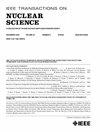Cu-Doped Cs₂AgI₃ Composite-Loaded Plastic Scintillators for X-Ray and Thermal Neutron Detection
IF 1.9
3区 工程技术
Q3 ENGINEERING, ELECTRICAL & ELECTRONIC
引用次数: 0
Abstract
Ag-based metal halide scintillators have recently attracted significant interest for X-ray imaging due to their high light yield and ultrafast decay lifetime. These properties are advantageous for thermal neutron detection, yet their application in this area has not been thoroughly explored. In this article, we investigate the properties of Cu-doped Cs2AgI3 metal halide scintillators for X-ray imaging and thermal neutron detection. A simple synthesis process was employed to produce Cu-doped Cs2AgI3 scintillators. The as-prepared Cu-doped Cs2AgI3 exhibited intense green emission with a photoluminescence quantum yield (PLQY) of 55%用于x射线和热中子探测的cu掺杂Cs₂AgI₃复合负载塑料闪烁体
银基金属卤化物闪烁体由于其高产光率和超快的衰变寿命,最近引起了x射线成像的极大兴趣。这些特性对热中子探测是有利的,但它们在该领域的应用还没有得到充分的探讨。在本文中,我们研究了cu掺杂Cs2AgI3金属卤化物闪烁体用于x射线成像和热中子探测的性质。采用简单的合成工艺制备了cu掺杂cs2ag3闪烁体。制备的cu掺杂Cs2AgI3具有强烈的绿色发光,光致发光量子产率(PLQY)为55% ~2.7 %。制备了cu掺杂的cs2ag3 /聚偏氟乙烯(PVDF)塑料闪烁屏,在x射线辐射下达到了5 lp/mm的分辨率。利用6LiF、cu掺杂Cs2AgI3和聚甲基丙烯酸甲酯(PMMA)组成的复合材料进行热中子探测,获得了约12 $526~\pm ~9$光子/热中子的光产率,几乎是商用6li -玻璃(GS20)闪烁体(7000光子/热中子)的两倍。使用网络动力学数字滤波器实现了有效的中子-伽马脉冲判别,有效地将热中子事件与伽马事件分离开来。
本文章由计算机程序翻译,如有差异,请以英文原文为准。
求助全文
约1分钟内获得全文
求助全文
来源期刊

IEEE Transactions on Nuclear Science
工程技术-工程:电子与电气
CiteScore
3.70
自引率
27.80%
发文量
314
审稿时长
6.2 months
期刊介绍:
The IEEE Transactions on Nuclear Science is a publication of the IEEE Nuclear and Plasma Sciences Society. It is viewed as the primary source of technical information in many of the areas it covers. As judged by JCR impact factor, TNS consistently ranks in the top five journals in the category of Nuclear Science & Technology. It has one of the higher immediacy indices, indicating that the information it publishes is viewed as timely, and has a relatively long citation half-life, indicating that the published information also is viewed as valuable for a number of years.
The IEEE Transactions on Nuclear Science is published bimonthly. Its scope includes all aspects of the theory and application of nuclear science and engineering. It focuses on instrumentation for the detection and measurement of ionizing radiation; particle accelerators and their controls; nuclear medicine and its application; effects of radiation on materials, components, and systems; reactor instrumentation and controls; and measurement of radiation in space.
 求助内容:
求助内容: 应助结果提醒方式:
应助结果提醒方式:


